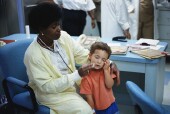Docs Make Push to Lower Kids? Pain, Stress in ER
Pediatric group recommends ways to better manage distress

MONDAY, Oct. 29 (HealthDay News) ? A trip to the emergency room often means a child is in pain, and it?s a near certainty that the visit will also be fraught with anxiety.
That?s why the American Academy of Pediatrics has issued a new report emphasizing the importance of controlling pain and anxiety in children who need emergency medical treatment.
?There are a lot of modalities for reducing pain in children, and we?re doing a lot better in terms of kids? pain than we used to,? said report author Dr. Joel Fein, an attending physician in the emergency department at the Children?s Hospital of Philadelphia.
?Parents should advocate for the children for pain and anxiety management? if they feel they aren?t getting adequate control, said Fein, who also is a professor of pediatrics and emergency medicine at the University of Pennsylvania?s Perelman School of Medicine.
The new report was published online Oct. 29 and in the November print issue of the journal Pediatrics.
There are many barriers to achieving a pain-free ER visit, according to the report. One is a fear of side effects. Another is a concern that giving medications to mask the pain might make it more difficult or time-consuming to make a diagnosis, which could affect treatment.
Even topical anesthetics might not be used if doctors believe they may delay the right diagnosis. Topical anesthetics also aren?t readily available in all emergency rooms, according to the report.
Narcotic medications still carry a stigma, and doctors may be less likely to use these drugs in children. What?s more, the report says there continues to be a racial bias in the prescription of these drugs, with black children less likely to receive them for pain relief.
The new report suggests that these barriers can be overcome, and that pain relief should start even before a child reaches the hospital if they are coming in an ambulance.
Once at the hospital, it?s important to keep the child calm. Increased anxiety leads to a greater perception of pain, according to the report. The authors recommended that each family be given a private room, ideally with colorful walls, pictures on the ceilings and a collection of toys or games to keep the child distracted in this unfamiliar environment.
The report suggested that medications such as acetaminophen, ibuprofen or oral narcotics can help relieve pain, as can topical analgesics. The report also recommends using topical anesthetics to numb areas before the placement of IV catheters.
?Children have a pretty significant fear of needles,? Fein said. ?Topical anesthesia can offer pain protection during IV line placement and [drawing blood].?
The report adds that the use of pain-relieving medications doesn?t appear to alter physicians? ability to make a diagnosis in a timely fashion.
Fein said that not all of the report?s recommendations have to do with medications. ?For the youngest infants, even just giving sugar water can help reduce pain,? he said.
Child life specialists are specifically trained to perform distraction procedures to help keep a child calm. These specialists can teach other members of the staff ways to keep children from focusing on their pain, Fein said.
One of these specialists agreed with Fein.
?I think we are all striving toward achieving the goal of pain-free emergency care,? said Dr. Hnin Khine, a pediatric emergency specialist at the Children?s Hospital at Montefiore in New York City.
?We can do most procedures now in a calmer way, but we still have more to do,? she said. ?This report is not a surprise, but it reminds us to stay on top of pain management.?
One important aspect to keeping a child calm is their parents, she said.
?Parents are often very anxious, recalling their own past ER experiences. It?s important that we educate parents as well as the child,? Khine said. ?They don?t have to tell their children to be strong even though it may hurt. We have to let them know that we can do this pain-free now. It?s a whole learning curve for all of us.?
More information
Learn more about taking your child to the ER from the Nemours Foundation?s KidsHealth.
 | Copyright ? 2011 HealthDay. All rights reserved
| Copyright ? 2011 HealthDay. All rights reserved
Related topics: Doctors and Health Care | Kids' Health | Mental Health | Pain and Pain Management | Public Health
Source: http://www.thehealthcast.com/kids-health/docs-make-push-to-lower-kids-pain-stress-in-er/
celebration church new york auto show 2012 tulsa easter eggs pineapple upside down cake free ecards flying car
No comments:
Post a Comment
Note: Only a member of this blog may post a comment.